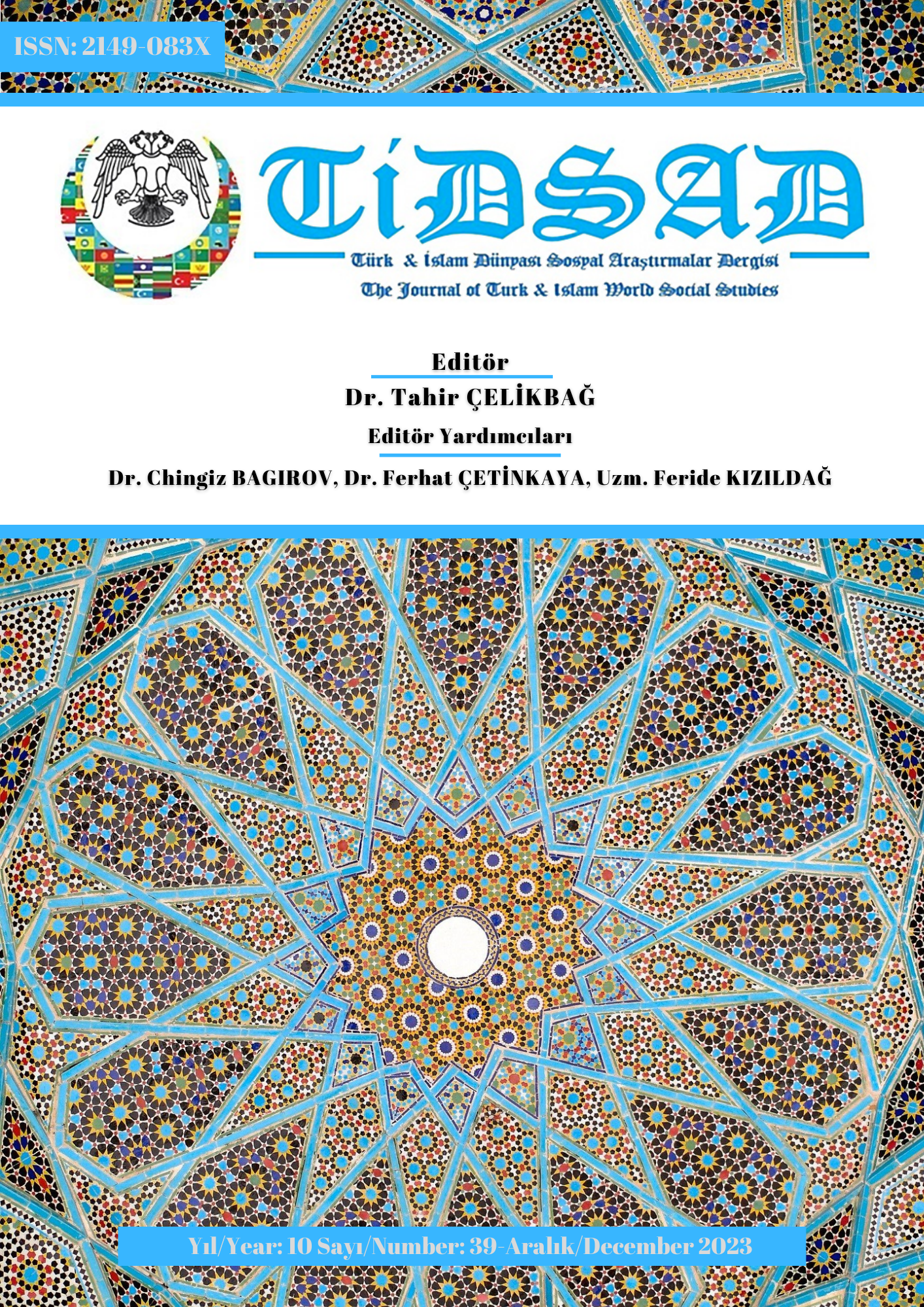Author :
Abstract
Bir dilin söz varlığı, sadece sözcüklerden oluşmaz. O dili konuşan toplumların kavramlar dünyasında; terimlerin, ikilemelerin, deyimlerin, atasözlerin, kalıp sözlerin ve çeşitli anlatım kalıplarının oluşturduğu sözler de mevcuttur. Toplumlar, maddi ve manevi kültürünü, dinî inançlarını, dünya görüşünü bu sözlerle dile getirmekte; bireyler çevresini, etrafındaki olayları, karşılaştığı durumları bu sözlerden oluşan kavramlarla anlatmaktadır. Bu bağlamda Türk dili tarihi için büyük önem taşıyan farklı coğrafyalarda ve dönemlerde kaleme alınan çok sayıda telif ya da tercüme eserden yararlanılabilir. Özellikle yazarların, şairlerin ya da sanatçıların ilgi odağı olan şehirlerin tarihî dokusunu, kültürel yapısını, edebî çehresini ve tabii güzelliklerini hatta yetiştirdiği ve tarihe mâl ettiği şahsiyetleri anlatan edebî metinlerden istifade edilebilir. 1815 yılında Abdüllatif Gazzizâde Efendi tarafından vefeyatnâme türünde kaleme alınan Hulâsatü’l-Vefeyât bunlardan biridir. İçeriği bakımından bir nevi hâl tercümesi özelliği taşıyan eser, aynı zamanda şehir monografisi özelliği de taşımaktadır. Eserde, Bursa şehrinin tarihî şahsiyetlerine, manevi ulularına, tanınmış alimlerine ait bilgiler verilmiş; tarihî yapılarına tabii güzelliklerine ve kültürel zenginliklerine temas edilmiştir. Bu bağlamda eser, kültür tarihi bakımından önemlidir. Ayrıca Türkçe, Arapça, Farsça kökenli sözcüklerin birlikte kullanımından oluşan orijinal tamlamaları, terimleri, deyimleri, ikilemeleri, güzel adlandırmaları içeren mevcut söz varlığıyla kayda değerdir. XIX. yüzyıl Osmanlı Türkçesi hakkında bilgilendirici niteliktedir. Kişi ve yer adlarından oluşan çok sayıda adı bünyesinde barındırmasıyla da ad bilimine katkıda bulunabilecek vasfa sahiptir. Bu çalışma; Hulâsatü’l-Vefeyât’ın söz örgüsünün önemli bir bölümünü teşkil eden terimler hakkındadır. Tarama ve fişleme yöntemiyle eserde dört yüz seksen beş terim kullanıldığı tespit edilmiştir. Bunlardan iki yüz seksen dördünün tasavvuf terminolojisine ait olduğu görülmüştür. Çalışma sırasında müellifin toplumsal kimliği de göz önünde tutularak din, tarih, tıp alanlarıyla ilgili terimlerin incelenmesi daha sonraki çalışmalara bırakılmış, sadece tasavvufî terimler dikkate alınmıştır. Yapılan çalışmada ilk önce müellif ve eseri ana hatlarıyla tanıtılmış sonra tespit edilen terimler anlamlarıyla birlikte verilmiştir. Birden fazla anlama sahip olan sözcükler, ayrı başlıklar altına alınmak yerine aynı başlık altında anlamları numaralandırılarak verilmiştir. Ayrıca eserde geçen terimlerin kullanım sıklığı belirlenerek tablolar şeklinde verilmiştir.
Keywords
Abstract
In order to reveal the word pattern of a language, it is necessary to have an authority of the vocabulary of that language. Although words is the first comes to mind when it comes to vocabulary, that language cannot be limited to words only. Vocabulary of a language; It is a whole formed by terms, reduplications, idioms, proverbs, word molds, and various expression patterns. It is possible to draw the limits of the expressive power and richness of expression of Turkish by examining this whole that constitutes its vocabulary. In this context, copyrighted or translated literary works written in different geographies and historical periods are of great importance for the Turkish language. In this context, in almost every period there are many works in which the historical texture, cultural structure, literary face and natural beauties of the cities, even the artists, writers, poets and state dignitaries are described. One of them is the work called Hulâsatü'l-Vefeyât, which deals with the material and spiritual values of the city of Bursa, which is one of the important centers of the Ottoman geography. Written in 1815 by Abdüllatif Gazzizâde Efendi in the kind of vefeyatnâme, Hulâsatü'l-Vefeyât is one of them. In terms of its content, the work, which is a kind of translation of the state of affairs, is also a city monograph. In the work, information about the historical figures, spiritual greats and well-known scholars of the city of Bursa is given; Its historical buildings, natural beauties and cultural richness are touched upon. In this context, the work is important in terms of cultural history. In addition, it is noteworthy for its existing vocabulary, which includes original phrases, terms, idioms, idioms, dilemmas and beautiful names formed by the use of words of Turkish, Arabic and Persian origin together. It is informative about nineteenth century Ottoman Turkish. This study is about the terms that constitute an important part of Hulāsat al-Vefeyāt's vocabulary. Through the method of scanning and tagging, it was determined that two hundred and eighty-four of the four hundred and eighty-five terms used in the work belong to Sufi terminology. Considering the social identity of the author during the study, the analysis of terms related to religion, history, and medicine was left for later studies, and only Sufi terms were taken into consideration. In this study, the author and his work are first introduced in outline and then the terms identified are given with their meanings. Words with more than one meaning are given under the same heading by numbering their meanings instead of being placed under separate headings. In addition, the frequency of use of the terms in the work is determined and given in the form of tables.





